Service History
The wooden three-masted schooner
Boaz was built in 1869 at the Stoakes and Locklin Shipyard in Sheboygan, Wisconsin.
Boaz as originally built was 82.8 feet long with a 21-foot beam and 7.8-foot depth of hold. It was built with a single centerboard, one deck, and three masts. Following a lengthening in 1874,
Boaz would be 114 feet long with a 22.3 feet beam and would still maintain the 7.8-foot depth of hold. The vessel was described as having a plain head and a square stern.
Boaz would also receive another centerboard trunk. Double centerboard schooners are a rare type of Great Lakes schooner that lasted only for a short duration on the Great Lakes. The additional centerboard would allow vessels like
Boaz to sail closer to the wind and therefore take cargo to market faster. The additional hardware would take up space in the cargo hold, but fast sailing allowed for additional voyages that would compensate for the loss of cargo capacity. Although it is uncertain when
Boaz received its second centerboard, it is presumed that it was during the 1874 overhaul.
Boaz spent its life on western Lake Michigan carrying lumber from Door County, Muskegon, Ludington, Sheboygan, and Racine down to Milwaukee and Chicago.
In early November 1873,
Boaz was caught in a squall that drove the vessel over Whaleback Shoal in Green Bay. The Crew was forced to cut the masts down. After the storm had lifted, the vessel was found drifting near Menominee, Michigan.
Boaz was then towed to Milwaukee by the propeller
G.J. Truesdell for repairs. Instead of repairing only the storm damage, the then-owners had the ship hauled out, cut in half, and lengthened by 32 feet.
On September 1878 12,
Boaz departed Traverse Bay, Michigan laden with wood bound for Milwaukee. By September 20, the vessel still had not arrived, and a search of regional ports was conducted to determine the whereabouts of the ship. The vessel had been delayed, when on the night of 15 September 1878, the cook, George Gunderson fell overboard near South Manitou Island.
Boaz wintered over 1878-79 in the Milwaukee River at Burnham's Slip along with the scow
Milton On May 16, 1879, the temporary railroad bridge placed across Burnham's Slip by the Chicago, Milwaukee & St. Paul Railway, while a new iron double track bridge was under construction, was removed to release
Boaz and
Milton from their winter quarters. Perhaps due to their wealth, the Burnhams carried no insurance on their vessels.
During a Lake Michigan crossing on April 24, 1886, from Burnham's Pier in Chicago to Milwaukee,
Boaz sprung a bad leak mid-lake. The crew was forced to jettison a large part of its cargo and operate the pumps. The ship arrived at Milwaukee on the morning of April 15 and was immediately put into the dry dock. Extensive repair and caulking were conducted on the vessel's hull.
When
Boaz passed through Sturgeon Bay on August 3, 1888, it was flying a Cleveland and Thurman banner in support of Democratic nominees for US President Grover Cleveland and Vice President Allen G. Thurman.
Final Voyage
On November 7, 1900,
Boaz was bound from Pierpont, Michigan, to Racine, Wisconsin, with a cargo of elm lumber, when it was caught in a storm and began leaking. The crew took to the pumps but had trouble keeping the ship free of water. The
Boaz headed to North Bay, a few miles north of the Cana Island lighthouse for refuge. In attempting to enter North Bay,
Boaz struck the point. The crew was able to free the vessel but missed the harbor. The crew set the anchors to keep the vessel off the beach, but at this point
Boaz was completely waterlogged and sank to its deck.
Fearing the schooner might roll over, the crew prepared the yawl. The small boat was fastened to the stern of the
Boaz and in this exposed position the four men spent the night in the rain and snow. The next morning the crew spotted the steam barge
Two Myrtles also sheltering in the harbor and went to the ship for assistance. The shipwreck victims were given clothes and fed a warm breakfast. The
Two Myrtles cut the anchors and towed the
Boaz into North Bay running it onto the beach near Marshall's pier.
The
Boaz was left in North Bay and eventually sunk. the cargo was salvaged and the vessel was abandoned. Tugs were sent from Sheboygan to free the schooner but the ship proved a total loss. The estimated value of the vessel and the cargo that remained was a $1500 total loss. On November 27, 1900, United States Marshall E.H. Hlantz filed a claim again the vessel on behalf of the sailors in wages in aggregate of $200. Captain Thomas Isabell, a local salvor, went to North Bay three years later and removed the spars from the wreck.
The final document of enrollment was surrendered in Milwaukee on June 25, 1901, noting the vessel as a total loss.
Today
The vessel lies in a small lagoon at the southwest end of Marshall's Point, North Bay, in 15 feet of water. The bow is oriented west-southwest. The bottom is light sand and weed-choked. The hull is generally intact to the turn of the bilge; it protrudes from the bottom; the wreck is visible from the surface. Much of the bilges are covered in sand, at least 12 feet deep. Sections of the bilge ceiling are exposed above the overburden, as are five strakes of the stern ceiling and the stern post. Other features include two pump shafts and two centerboard trunks. There is also present miscellaneous planking inshore of the site, and lengths of hawser-laid cable found in the vicinity of the pump shafts which may belong to the vessel; these may have othwerwise been left by salvage attempts in the 1960s.
Although mapped in a 1988 survey, archaeologists returned to the site on June 4, 1991, for a brief inspection. There, they recorded further details of the vessel's midship framing pattern. Wisconsin Historical Society archaeologists returned in 2022 to survey the wreck again.
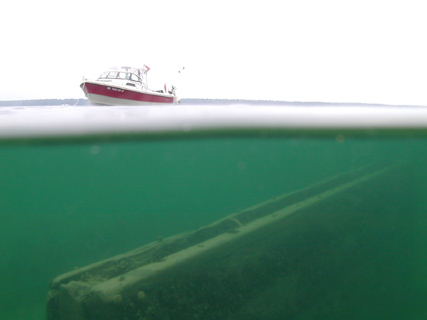
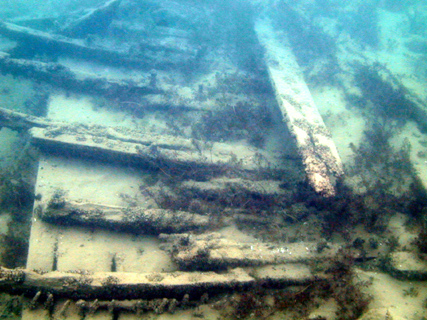
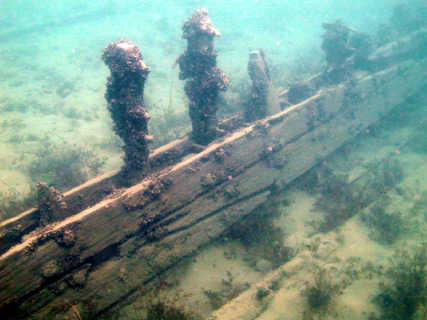
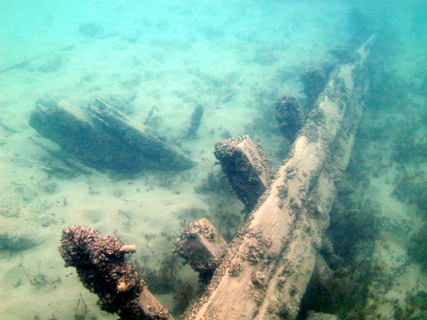
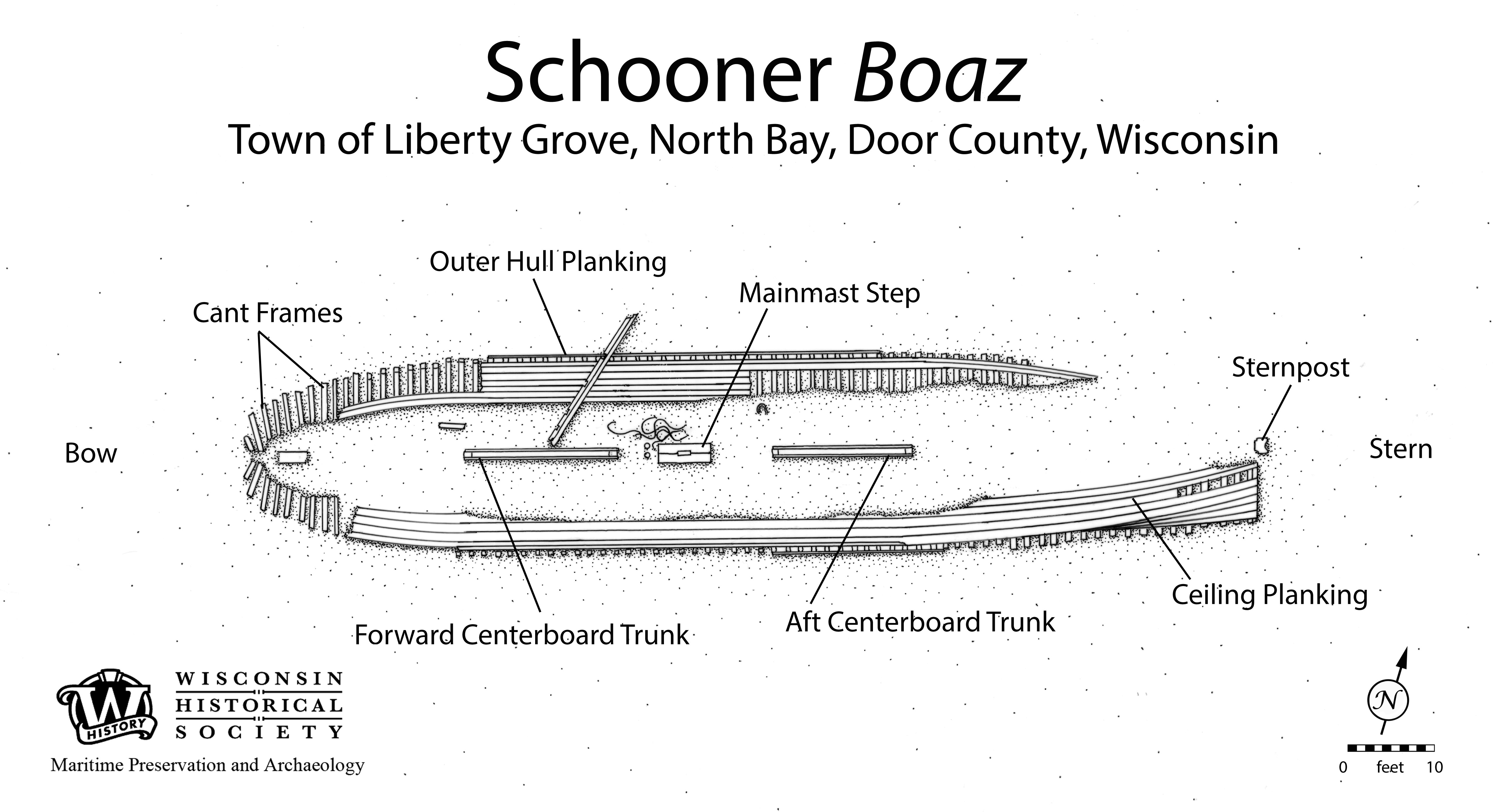
_0001.jpg)
_0004.jpg)
_0003.JPG)
_0002.JPG)

 Confirmed Location
Confirmed Location
 Unconfirmed location
Unconfirmed location